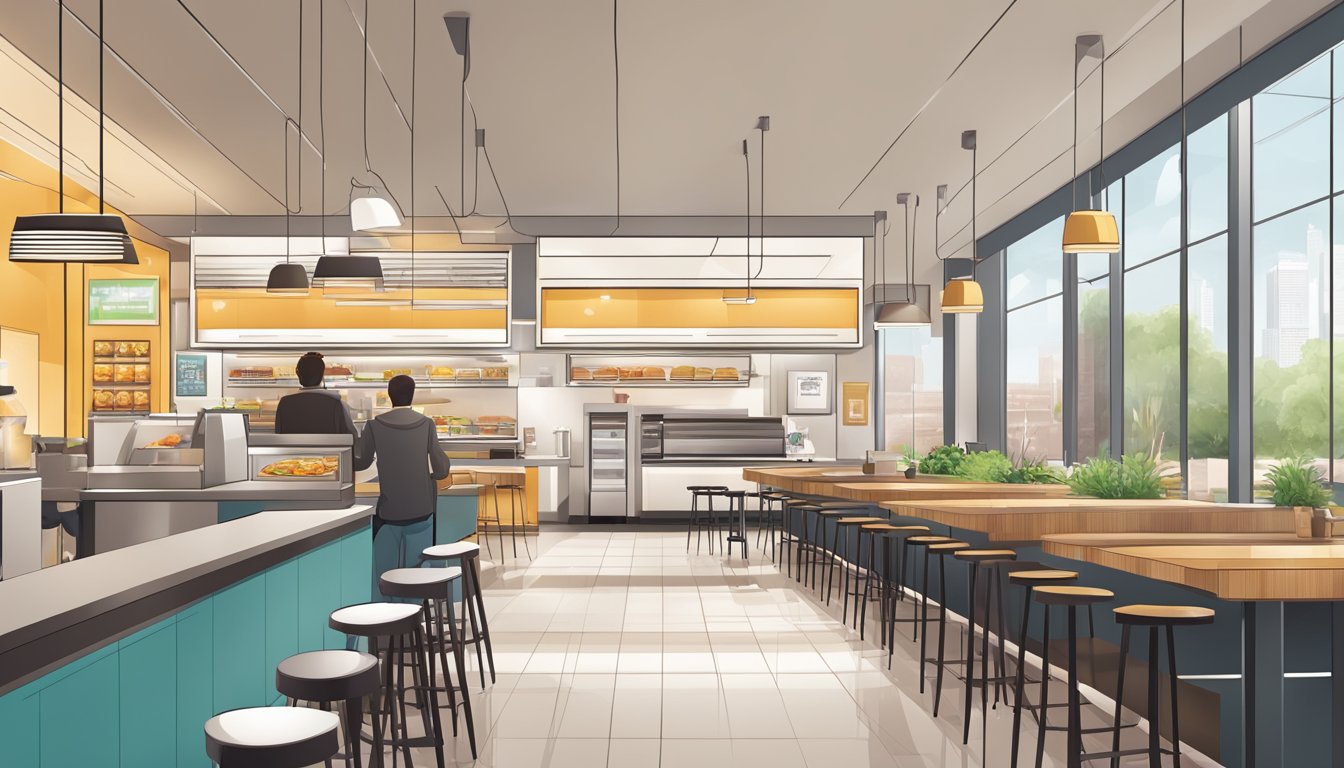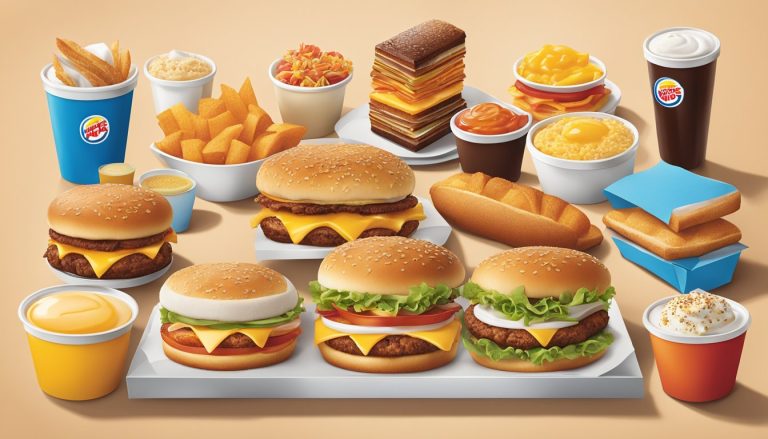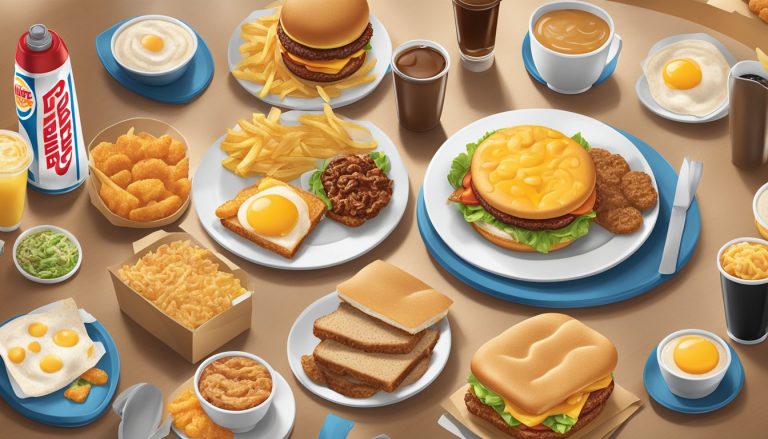Burger King’s breakfast menu and restaurant design have both undergone significant transformations since the company’s inception in 1953. The fast food giant has adapted to changing consumer preferences and market trends, continually updating its offerings and aesthetic appeal.
Burger King’s restaurant designs have evolved from simple, functional spaces to more modern, inviting environments that cater to diverse customer needs. The BK 2500 design introduced in 1989 marked a major shift, becoming the most popular image for over a decade. This evolution in design reflects broader changes in the fast food industry, as chains compete to create distinctive dining experiences.
BK’s breakfast menu has also expanded and evolved over the years, mirroring the growing importance of morning meals in the fast food sector. As Burger King continues to innovate, its approach to both menu development and restaurant design serves as a microcosm of the wider fast food industry’s evolution.
History of Burger King and Fast Food Innovation
Burger King’s journey from a small Florida restaurant to a global fast food empire spans decades of innovation and expansion. The company’s growth parallels major shifts in American dining culture and franchising practices.
Founding of Insta-Burger King
Insta-Burger King emerged in Jacksonville, Florida in 1953. Keith J. Kramer and Matthew Burns founded the company, drawing inspiration from the McDonald brothers’ successful operation in California. Their concept centered around a novel cooking device called the Insta-Broiler, which efficiently prepared burgers.
The original restaurant quickly gained popularity for its flame-broiled patties. This unique cooking method set Insta-Burger King apart from competitors and laid the groundwork for future success.
Key Figures: McLamore and Edgerton
James McLamore and David Edgerton played pivotal roles in transforming Insta-Burger King into a fast food powerhouse. In 1954, they opened the first franchise location in Miami, Florida.
The duo introduced crucial innovations. Most notably, they created the Whopper in 1957, which became Burger King’s signature sandwich. McLamore and Edgerton’s business acumen and menu development skills propelled the chain’s early growth.
From Insta-Burger to BK: A Transition
In 1959, McLamore and Edgerton purchased the entire Insta-Burger King franchise from its original founders. They renamed the company “Burger King Corporation” and began a period of rapid expansion.
The partners refined the restaurant concept, focusing on flame-broiled burgers as a key differentiator. They also improved operational efficiency and standardized practices across locations.
Expansion and Franchise Evolution
Burger King’s franchise model fueled its growth throughout the 1960s and beyond. The company developed a system that allowed for rapid expansion while maintaining consistency across locations.
Key milestones include:
- 1967: Pillsbury Company acquires Burger King
- 1970s: International expansion begins
- 1980s: Introduction of drive-thru service
Burger King continually adapted its menu and restaurant designs to meet changing consumer preferences. The company embraced new technologies and marketing strategies to compete in the evolving fast food landscape.
BK’s Brand Identity and Logo Evolution
Burger King’s visual identity has undergone significant changes since its inception. The company’s logo and branding efforts reflect its growth from a small regional chain to a global fast-food powerhouse.
Early Branding and the Insta-Burger Logo
Burger King’s origins trace back to 1953 when it was known as Insta-Burger King. The initial logo featured a simple, text-based design with a stylized sun behind the company name. This logo represented the brand’s Florida roots and conveyed a sense of warmth and quick service.
In 1954, the company rebranded as Burger King. The new logo introduced a king character sitting on a burger-shaped throne. This playful design aimed to position the brand as royalty in the fast-food industry.
Rebranding Movements and Logo Redesigns
The 1960s saw the introduction of the now-iconic “bun halves” logo. This design featured the Burger King name between two stylized bun halves, creating a simple yet memorable visual identity.
In 1969, the logo underwent another significant change. The new design incorporated a burger icon with the company name, emphasizing the core product offering.
The 1990s brought a modernized version of the “bun halves” logo. This redesign featured a tilted, more dynamic look with a blue swoop, signaling the brand’s evolution and energy.
Brand Positioning and Public Perception
In 2021, Burger King unveiled a major rebrand. The new logo returned to a simplified version of the classic “bun halves” design. This move aimed to evoke nostalgia while presenting a clean, modern look suitable for digital platforms.
The rebrand also included updated packaging, uniforms, and restaurant designs. These changes sought to reinforce Burger King’s commitment to quality ingredients and a more premium fast-food experience.
Public reception to the new branding has been largely positive. Many view it as a successful blend of heritage and contemporary design, helping Burger King stay relevant in a competitive market.
Strategic Advertising and Marketing Endeavors

Burger King’s promotional efforts have evolved to capture consumer attention and drive sales. The company employs creative campaigns, innovative packaging, and digital technologies to engage customers and strengthen brand identity.
Signature Advertising Campaigns
Burger King’s advertising campaigns often feature bold, humorous approaches. The “Have It Your Way” slogan, introduced in the 1970s, emphasized customization. In 2004, the iconic “Subservient Chicken” website allowed users to type commands for a person in a chicken costume, generating viral buzz. The “Whopper Sacrifice” Facebook app in 2009 rewarded users with a free Whopper for unfriending 10 people. More recently, the “Moldy Whopper” campaign showcased a time-lapse of a decomposing burger to highlight the absence of artificial preservatives.
Packaging Design and Menu Boards
BK’s packaging has undergone several redesigns to reflect brand values and improve functionality. The company introduced recyclable packaging in many markets to align with sustainability goals. Menu boards evolved from static displays to digital screens, allowing for dynamic pricing and promotions. Typography on packaging and menus emphasizes clarity and brand consistency, with the Burger King logo prominently featured. The Whopper wrapper design often highlights the sandwich’s ingredients and size.
Leveraging New Technologies in Marketing
Burger King has embraced digital platforms to reach tech-savvy consumers. The BK app offers mobile ordering, personalized deals, and loyalty rewards. Geofencing technology triggers promotional push notifications when customers are near restaurants. On social media, BK employs witty posts and real-time marketing to engage followers. The company has also experimented with augmented reality, including a feature that allows app users to “burn” competitors’ ads to unlock Burger King coupons. These tech-driven initiatives aim to enhance customer experiences and drive foot traffic to physical locations.
Culinary Offerings and Menu Development
Burger King’s menu has evolved significantly since its inception, expanding from flame-grilled burgers to a diverse array of breakfast items, salads, and limited-time offerings. This evolution reflects changing consumer tastes and the brand’s adaptability in the fast-food landscape.
The Iconic Whopper and Flame-Grilled Burgers
The Whopper, introduced in 1957, remains Burger King’s signature item. This quarter-pound beef patty, flame-grilled to enhance flavor, is topped with fresh lettuce, tomatoes, mayonnaise, pickles, and onions on a sesame seed bun.
Burger King’s commitment to flame-grilling sets it apart from competitors. This cooking method imparts a distinct smoky flavor to their burgers, appealing to customers seeking a more “backyard barbecue” taste.
The chain has expanded its burger offerings over time. Options now include variations like the Bacon King, Double Whopper, and plant-based Impossible Whopper, catering to diverse preferences and dietary needs.
Extension of Menu: From Burgers to Breakfast
Burger King entered the breakfast market in the 1970s, recognizing the growing demand for convenient morning meals. The breakfast menu has since become a significant part of BK’s offerings.
Key breakfast items include:
- Croissan’wich: A croissant sandwich with eggs, cheese, and choice of meat
- Breakfast Burrito: Filled with scrambled eggs, sausage, cheese, and hash browns
- French Toast Sticks: A sweet option popular with both kids and adults
BK’s breakfast menu competes directly with other fast-food chains, offering a mix of traditional breakfast fare and unique items to attract morning customers.
Diversification: Salads, Limited-Time Offers, and Beyond
Burger King has diversified its menu to appeal to health-conscious consumers and those seeking variety. Salads were introduced as lighter alternatives to burgers and fries.
Limited-time offers (LTOs) play a crucial role in Burger King’s menu strategy. These temporary items create buzz and drive customer visits. Examples include:
- Seasonal offerings like the Pumpkin Spice Oreo Shake
- Collaborations with popular brands, such as the Mac n’ Cheetos
- Unique burger creations like the Black Whopper
BK has also expanded into chicken offerings, desserts, and value menu items. This diversification helps the chain compete in various fast-food segments and cater to a wide range of customer preferences and budgets.
Physical Space: Rethinking Fast-Food Restaurant Design

Fast-food restaurant design has undergone significant transformations in recent years. Brands are reimagining their spaces to enhance customer experience, improve efficiency, and reflect evolving consumer preferences.
Evolution of Architectural Aesthetics
Fast-food chains are moving away from cookie-cutter designs towards more distinctive architectural styles. Exterior facades now incorporate modern materials like glass, steel, and sustainable elements. Many brands opt for sleek, minimalist designs that convey cleanliness and efficiency.
Bold color palettes and custom typefaces help create unique brand identities. McDonald’s, for instance, has shifted from its iconic red and yellow to more subdued earth tones in many locations. Logos and emblems are often integrated into the building’s structure, serving as both design elements and brand reinforcement.
Lighting plays a crucial role in creating ambiance. LED systems allow for dynamic color changes, adapting the mood throughout the day.
Interior Spaces and Customer Experience
Inside, fast-food restaurants are focusing on creating welcoming environments that encourage longer stays. Comfortable seating options, including booths and lounge areas, replace hard plastic chairs.
Digital menu boards offer flexibility and eye-catching displays. Self-order kiosks reduce wait times and free up staff for other tasks. Many chains now incorporate charging stations and free Wi-Fi to cater to tech-savvy customers.
Natural materials like wood and stone add warmth to interiors. Plants and green walls bring nature indoors, promoting a healthier image. Some brands use local art or photography to connect with their communities.
Innovations in Restaurant Layouts
Efficient layouts are crucial for fast-food operations. Many chains now employ a linear design for streamlined service flow. This approach minimizes congestion and reduces wait times.
Drive-thru lanes are being reimagined with multiple ordering points and dedicated pickup windows for mobile orders. Some restaurants feature separate entrances for dine-in and takeout customers to manage traffic.
Open kitchens allow customers to see food preparation, enhancing transparency. This design element also creates a sense of theater and freshness. Modular furniture and adaptable spaces enable restaurants to reconfigure for different dayparts or events.
Franchising Model and Operational Strategies

Burger King’s franchise system forms the backbone of its global expansion strategy. The company’s operational excellence and strategic location choices have played crucial roles in its growth and market presence.
The Growth of the Franchise System
Burger King’s franchise model has been instrumental in its rapid expansion. The company grants franchisees the rights to operate restaurants under the Burger King brand, providing them with established processes and brand recognition. This system allows Burger King to grow without bearing all the costs and risks of opening new locations.
Restaurant Brands International, Burger King’s parent company, oversees the franchise operations. The franchise agreement typically includes initial fees, ongoing royalties, and adherence to strict operational standards. This model has enabled Burger King to maintain consistency across its global network while leveraging local market knowledge.
Franchisees benefit from Burger King’s marketing initiatives, supply chain management, and operational support. The company continually refines its franchise strategy to adapt to changing market conditions and consumer preferences.
Operational Excellence and Burger King Locations
Burger King prioritizes operational efficiency in its restaurant locations. The company employs a strategic approach to site selection, considering factors such as population density, traffic patterns, and local competition.
Key aspects of Burger King’s operational strategy include:
- Standardized processes for food preparation and service
- Efficient kitchen layouts to maximize productivity
- Regular training programs for staff to maintain quality standards
- Implementation of technology for order management and customer service
Burger King launched Operation Phoenix to revitalize its restaurants and improve the customer experience. This initiative focuses on modernizing restaurant designs, enhancing drive-thru efficiency, and upgrading kitchen equipment.
The company also emphasizes flexibility in its restaurant formats, adapting to various locations such as standalone buildings, food courts, and drive-thru-only units. This adaptability allows Burger King to penetrate diverse markets and maximize its presence in different types of retail environments.
Challenges, Setbacks, and Revival Efforts

Burger King faced significant hurdles during economic downturns but implemented strategic initiatives to revitalize its brand and operations. The company adapted to market shifts through partnerships and menu innovations.
Coping with the Financial Crisis
The 2008 financial crisis hit Burger King hard. Sales declined as consumers cut back on dining out. The company closed underperforming locations and reduced staff to cut costs. Menu prices were adjusted to attract budget-conscious customers.
Burger King introduced value meal options to compete with other fast food chains. The $1 Whopper Jr. promotion aimed to boost traffic. Marketing efforts focused on the affordability of BK’s menu items compared to casual dining restaurants.
Despite these efforts, Burger King struggled to maintain market share against competitors like McDonald’s, which weathered the crisis more successfully.
Revival through Strategic Partnerships
To regain momentum, Burger King formed key partnerships. In 2010, the company was acquired by 3G Capital, bringing fresh capital and management expertise. This led to a restructuring of operations and a renewed focus on franchising.
Burger King merged with Tim Hortons in 2014, forming Restaurant Brands International. This move expanded its global reach and resources. The company leveraged Tim Hortons’ expertise to improve its breakfast offerings.
Partnerships with delivery services like DoorDash and Uber Eats helped Burger King adapt to changing consumer preferences for convenience and home delivery.
Adapting to Market Variations
Burger King recognized the need to evolve its menu and restaurant design. The company introduced healthier options to appeal to health-conscious consumers. Salads, grilled chicken sandwiches, and fruit smoothies were added to the menu.
BK Whopper Bar, a premium concept, was launched to target urban markets and compete with fast-casual restaurants. These locations offered customizable Whoppers and a more upscale dining experience.
Digital ordering kiosks and mobile apps were implemented to streamline the ordering process and appeal to tech-savvy customers. Restaurant layouts were redesigned to accommodate these new technologies and improve efficiency.




